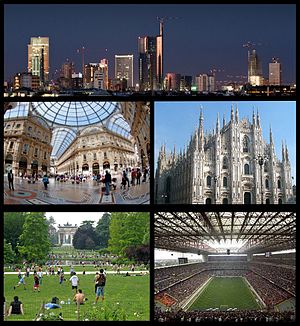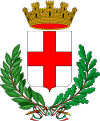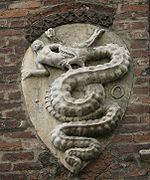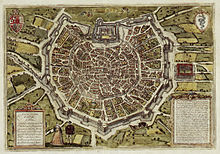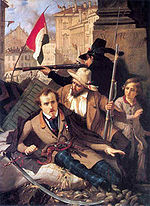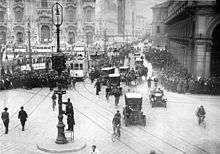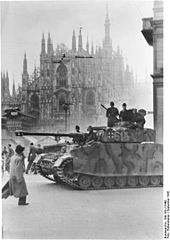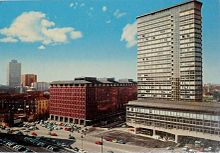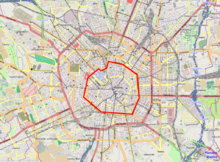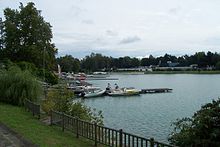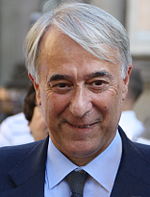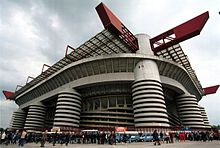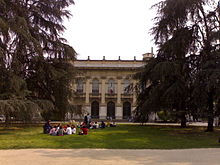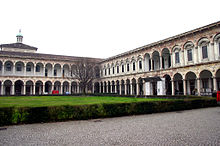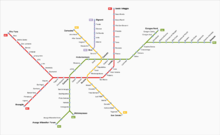
Milan
Did you know...
SOS Children has tried to make Wikipedia content more accessible by this schools selection. SOS mothers each look after a a family of sponsored children.
| Milan Milano |
|||
|---|---|---|---|
| — Comune — | |||
| Comune di Milano | |||
| From top, clockwise: Porta Nuova Business District, Milan Cathedral, San Siro Stadium, Parco Sempione with the Arch of Peace in the background, Galleria Vittorio Emanuele II | |||
|
|||
| Nickname(s): The Moral Capital of Italy | |||
|
|
|||
| Coordinates: 45°27′51″N 09°11′25″E Coordinates: 45°27′51″N 09°11′25″E | |||
| Country | Italy | ||
| Region | Lombardy | ||
| Province | Milan (MI) | ||
| Settled by Celts | as Mediolanum c. 400 BC | ||
| Government | |||
| • Mayor | Giuliano Pisapia ( I) |
||
| Area | |||
| • Total | 181.76 km2 (70.18 sq mi) | ||
| Elevation | 120 m (390 ft) | ||
| Population (june 2012) | |||
| • Total | 1,350,267 | ||
| • Density | 7,400/km2 (19,000/sq mi) | ||
| Demonym | Milanees/Milanese | ||
| Time zone | CET ( UTC+1) | ||
| • Summer ( DST) | CEST ( UTC+2) | ||
| Postal code | 20100, 20121–20162 | ||
| Dialing code | 02 | ||
| Patron saint | Ambrose | ||
| Saint day | 7 December | ||
| Website | Official website | ||
Milan (Italian: Milano [miˈlaːno]; Lombard: Milan [miˈlãŋ]; Latin: Mediolanum) is the second-largest city in Italy and the capital of Lombardy. The city proper has a population of about 1.35 million, while its urban area is the 5th largest in the EU and the largest in Italy with an estimated population of about 5.2 million. The massive suburban sprawl that followed the Italian economic miracle of 1950s–60s and the growth of a vast commuter belt, suggest that socioeconomic linkages have expanded well beyond the boundaries of its administrative limits and its agglomeration, creating a metropolitan area of 7-9 million people. It has been suggested that the Milan metropolitan area is part of the so-called Blue Banana, the area of Europe with the highest population and industrial density.
Milan was founded by the Insubres, a Celtic people. The city was later conquered by the Romans, becoming the capital of the Western Roman Empire. During the Middle Ages, Milan flourished as a commercial and banking centre. In the course of centuries, it has been alternatively dominated by the Spanish, the Austrians and the French, until when in 1859 the city was eventually annexed by the new Kingdom of Italy. During the early 1900s, Milan led the industrialization process of the young nation, being at the very centre of the economic, social and political debate. Badly affected by the World War II devastations, and after a harsh Nazi occupation, the city became the main centre of the Italian Resistance. In post-war years, the city enjoyed a prolonged economic boom, attracting large flows of immigrants from rural Southern Italy. During the last decades, Milan has seen a dramatic rise in the number of international migrants, and today more than one sixth of its population is foreign born.
Milan is the main industrial, commercial and financial centre of Italy and a leading global city. Its business district hosts the Italian Stock Exchange and the headquarters of the largest national banks and companies. The city is a major world fashion and design capital. Thanks to its important museums, theatres and landmarks (including the Milan Cathedral, the fourth largest cathedral in the world, and Santa Maria delle Grazie, decorated with Leonardo da Vinci paintings, a UNESCO World Heritage Site) Milan attracts more than two million annual visitors. It hosts numerous cultural institutions and universities, with 185,000 enrolled students in 2011, i.e. 11 percent of the national total. The city is also well known for several international events and fairs, including Milan Fashion Week and the Milan Furniture Fair, the largest of its kind in the world, and will host the 2015 Universal Exposition. Milan is home to two of the world's major football teams, A.C. Milan and F.C. Internazionale Milano.
History
Toponymy
The etymology of Milan is uncertain. While the modern name of the city is clearly derived from its Latin name Mediolanum (from the Latin words medio, meaning "in the middle", and lanus, "plain"), it has been suggested that its original roots could lie more deeply in the city's Celtic heritage. Indeed, the name "Mediolanum" is borne by about sixty Gallo-Roman sites all over France, such as Saintes (Mediolanum Santonum) and Évreux (Mediolanum Aulercorum), as every Celtic community had its sacred assembly place of law and justice, usually placed at the midpoint of their territory. In addition, some scholars have suggested that the second element of the Latin name, lanum, could be identified with the Celtic root lan, signifying an enclosure or demarcated territory (source of the Welsh word 'llan', meaning a sanctuary or church) in which Celtic communities used to build shrines. Hence, Mediolanum could signify the central town or sanctuary of a particular Celtic tribe.
Another theory links the origin of the name to the boar sow (the Scrofa semilanuta) an ancient emblem of the city, fancifully accounted for in Andrea Alciato's Emblemata (1584), beneath a woodcut of the first raising of the city walls, where a boar is seen lifted from the excavation, and the etymology of Mediolanum given as "half-wool", explained in Latin and in French. The foundation of Milan is credited to two Celtic peoples, the Bituriges and the Aedui, having as their emblems a ram and a boar; therefore "The city's symbol is a wool-bearing boar, an animal of double form, here with sharp bristles, there with sleek wool." Alciato credits Ambrose for his account.
Prehistory and antiquity
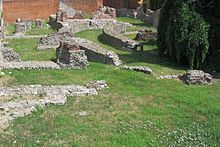
Around 400 BC, the Celtic Insubres settled Milan and the surrounding region. In 222 BC, the Romans conquered the settlement, which was then renamed Mediolanum. After several centuries of Roman control, Milan was declared the capital of the Western Roman Empire by Emperor Diocletian in 286 AD. Diocletian chose to stay in the Eastern Roman Empire (capital Nicomedia) and his colleague Maximianus ruled the Western one. Immediately Maximian built several gigantic monuments, like a large circus 470 m × 85 m (1,540 ft × 279 ft), the Thermae Herculeae, a large complex of imperial palaces and several other services and buildings.
With the Edict of Milan of 313, Emperor Constantine I guaranteed freedom of religion for Christians. The city was besieged by the Visigoths in 402, so the imperial residence was moved to Ravenna. In 452, the Huns overran the city. In 539, the Ostrogoths conquered and destroyed Milan in the course of the Gothic War against Byzantine Emperor Justinian I. In the summer of 569, the Lombards (from which the name of the Italian region Lombardy derives), a Teutonic tribe conquered Milan, overpowering the small Byzantine army left for its defence. Some Roman structures remained in use in Milan under Lombard rule. Milan surrendered to the Franks in 774 when Charlemagne, in an utterly novel decision, took the title "King of the Lombards" as well (before then the Germanic kingdoms had frequently conquered each other, but none had adopted the title of King of another people). The Iron Crown of Lombardy dates from this period. Subsequently Milan become part of the Holy Roman Empire.
Middle Ages
During the Middle Ages, Milan prospered as a centre of trade due to its command of the rich plain of the Po and routes from Italy across the Alps. The war of conquest by Frederick I Barbarossa against the Lombard cities brought the destruction of much of Milan in 1162. After the founding of the Lombard League in 1167, Milan took the leading role in this alliance. As a result of the independence that the Lombard cities gained in the Peace of Constance in 1183, Milan became a duchy. In 1208 Rambertino Buvalelli served a term as podestà of the city, in 1242 Luca Grimaldi, and in 1282 Luchetto Gattilusio. The position could be fraught with personal dangers in the violent political life of the medieval commune: in 1252 Milanese heretics assassinated the Church's Inquisitor, later known as Saint Peter Martyr, at a ford in the nearby contado; the killers bribed their way to freedom, and in the ensuing riot the podestà was very nearly lynched. In 1256 the archbishop and leading nobles were expelled from the city. In 1259 Martino della Torre was elected Capitano del Popolo by members of the guilds; he took the city by force, expelled his enemies, and ruled by dictatorial powers, paving streets, digging canals, successfully taxing the countryside. His policy, however, brought the Milanese treasury to collapse; the use of often reckless mercenary units further angered the population, granting an increasing support for the Della Torre's traditional enemies, the Visconti. It is worthy of note that the most important industries throughout the period were major armaments and wool production, a whole catalogue of activities and trades is given in Bonvesin della Riva's "de Magnalibus Urbis Mediolani".
On 22 July 1262 Ottone Visconti was created archbishop of Milan by Pope Urban IV, against the Della Torre candidate, Raimondo della Torre, Bishop of Como. The latter thus started to publicize allegations of the Visconti's closeness to the heretic Cathars and charged them of high treason: the Visconti, who accused the Della Torre of the same crimes, were then banned from Milan and their properties confiscated. The ensuing civil war caused more damage to Milan's population and economy, lasting for more than a decade. Ottone Visconti unsuccessfully led a group of exiles against the city in 1263, but after years of escalating violence on all sides, finally, after the victory in the Battle of Desio (1277), he won the city for his family. The Visconti succeeded in ousting the della Torre forever, ruling the city and its possession until the 15th century.
Much of the prior history of Milan was the tale of the struggle between two political factions: the Guelphs and the Ghibellines. Most of the time the Guelphs were successful in the city of Milan. However, the Visconti family were able to seize power (signoria) in Milan, based on their "Ghibelline" friendship with the German Emperors. In 1395, one of these emperors, Wenceslas (1378–1400), raised the Milanese to the dignity of a duchy. Also in 1395, Gian Galeazzo Visconti became duke of Milan. The Ghibelline Visconti family was to retain power in Milan for a century and a half from the early 14th century until the middle of the 15th century.
In 1447 Filippo Maria Visconti, Duke of Milan, died without a male heir; following the end of the Visconti line, the Ambrosian Republic was enacted. The Ambrosian Republic took its name from St. Ambrose, popular patron saint of the city of Milan. Both the Guelph and the Ghibelline factions worked together to bring about the Ambrosian Republic in Milan. However, the Republic collapsed when in 1450, Milan was conquered by Francesco Sforza, of the House of Sforza, which made Milan one of the leading cities of the Italian Renaissance.
Early modern
The French king Charles VIII first laid claim to the duchy in 1492. At that time, Milan was defended by Swiss mercenaries. After the victory of Louis's successor François I over the Swiss at the Battle of Marignan, the duchy was promised to the French king François I. When the Habsburg Charles V defeated François I at the Battle of Pavia in 1525, northern Italy, including Milan, passed to the House of Habsburg.
In 1556, Charles V abdicated in favour of his son Philip II and his brother Ferdinand I. Charles's Italian possessions, including Milan, passed to Philip II and the Spanish line of Habsburgs, while Ferdinand's Austrian line of Habsburgs ruled the Holy Roman Empire. The Great Plague of Milan in 1629–31 killed an estimated 60,000 people out of a population of 130,000. This episode is considered one of the last outbreaks of the centuries-long pandemic of plague that began with the Black Death.
In 1700 the Spanish line of Habsburgs was extinguished with the death of Charles II. After his death, the War of the Spanish Succession began in 1701 with the occupation of all Spanish possessions by French troops backing the claim of the French Philippe of Anjou to the Spanish throne. In 1706, the French were defeated in Ramillies and Turin and were forced to yield northern Italy to the Austrian Habsburgs. In 1713, the Treaty of Utrecht formally confirmed Austrian sovereignty over most of Spain's Italian possessions including Lombardy and its capital, Milan.
Napoleon invaded Italy in 1796, and Milan was declared capital of the Cisalpine Republic. Later, he declared Milan capital of the Kingdom of Italy and was crowned in the Duomo. Once Napoleon's occupation ended, the Congress of Vienna returned Lombardy, and Milan, along with Veneto, to Austrian control in 1815. During this period, Milan became a centre of lyric opera. Here in the 1770s Mozart had premiered three operas at the Teatro Regio Ducal. Later La Scala became the reference theatre in the world, with its premières of Bellini, Donizetti, Rossini and Verdi. Verdi himself is interred in the Casa di Riposo per Musicisti, his present to Milan. In the 19th century other important theatres were La Cannobiana and the Teatro Carcano.
On 18 March 1848, the Milanese rebelled against Austrian rule, during the so-called " Five Days" (Italian: Le Cinque Giornate), and Field Marshal Radetzky was forced to withdraw from the city temporarily. However, after defeating Italian forces at Custoza on 24 July, Radetzky was able to reassert Austrian control over Milan and northern Italy. However, Italian nationalists, championed by the Kingdom of Sardinia, called for the removal of Austria in the interest of Italian unification. Sardinia and France formed an alliance and defeated Austria at the Battle of Solferino in 1859. Following this battle, Milan and the rest of Lombardy were incorporated into the Kingdom of Sardinia, which soon gained control of most of Italy and in 1861 was rechristened as the Kingdom of Italy.
The political unification of Italy cemented Milan's commercial dominance over northern Italy. It also led to a flurry of railway construction that had started under Austrian partronage (Venice–Milan; Milan–Monza) that made Milan the rail hub of northern Italy. Thereafter with the opening of the Gotthard (1881) and Simplon (1906) railway tunnels, Milan became the major South European rail focus for business and passenger movements e.g. the Simplon Orient Express. Rapid industrialization and market expansion put Milan at the centre of Italy's leading industrial region, though in the 1890s Milan was shaken by the Bava-Beccaris massacre, a riot related to a high inflation rate. Meanwhile, as Milanese banks dominated Italy's financial sphere, the city became the country's leading financial centre.
Late modern and contemporary
In 1919, Fascist leader Benito Mussolini organized his Blackshirts in Milan, that rallied for the first time in Piazza San Sepolcro, a small square near Milan Cathedral. Subsequently, Mussolini led his March on Rome starting from the city. During the Second World War Milan suffered extensive damage from Allied bombings. When Italy quit the war in 1943, German forces occupied most of Northern Italy until 1945. As a result, antifascist resistance groups formed and started guerilla warfare against Nazi and Italian Social Republic's troops. As the war came to an end, the American 1st Armored Division advanced on Milan as part of the Po Valley Campaign. But before they arrived, members of the resistance seized control of the city and executed Mussolini along with several members of his collaborationist government. On 29 April 1945, the corpses of Mussolini, his mistress Clara Petacci and other Fascist leaders were infamously hanged in Piazzale Loreto, where a year before fifteen partisans had been executed.
During the post-war economic miracle, a large wave of internal migration (especially from rural areas of Southern Italy), moved to the city, bringing the population from 1.3 million in 1951 to 1.7 million in 1967. During this period, Milan saw a quick reconstruction of most of its destroyed facilities, with the building of several innovative and modernist skyscrapers, such as the Torre Velasca and the Pirelli Tower, that soon became symbols of the boom. The economic prosperity was however overshadowed in the late 1960s and early 1970s during the so-called Years of Lead, when Milan witnessed an unprecedented wave of street violence, labour strikes and political terrorism. The apex of this period of turmoil occurred on 12 December 1969, when a bomb exploded at the National Agrarian Bank in Piazza Fontana, killing seventeen people and injuring eighty-eight.
In the 1980s, as several fashion firms based in the city became internationally successful (such as Armani, Versace and Dolce & Gabbana), Milan became one of the world's fashion capitals. The city saw also a marked rise in international tourism, notably from America and Japan, while the stock exchange increased its market capitalization more than five-fold. This short-lived period of collective euphoria and the new international image of the city led the mass media to nickname the metropolis "Milano da bere", literally "Milan to drink". However, in the 1990s, Milan was badly affected by Tangentopoli, a large political scandal in which many local and national politicians and businessmen were tried for alleged corruption. The city was also affected by a severe financial crisis and a steady decline in textiles, automobile and steel production, that led to a deep reorganization of its economy.
In the early 21st century, Milan underwent a series of massive redevelopments, with the moving of its exhibition centres to a much larger site in the satellite town of Rho, and the construction of a new financial district in Porta Nuova. Despite the decline in Milan's manufacturing production, the city has found alternative and successful sources of revenue, including publishing, finance, banking, food processing, information technology, logistics, transport and tourism. The 2010 official announcement of Milan hosting Expo 2015 has brightened prospects for the city's future, with several new plans of regeneration and the planned construction of numerous futuristic structures. In addition, the city's decades-long population decline seems to have come to an end in recent years, with signs of recovery as it grew by seven percent since the last census.
Geography
Topography
Milan is located in the north-western section of the Po Valley, approximately half-way between the river Po to the south and the first reliefs of the Alps to the north, with the Ticino river to the west and the Adda to the east. The municipal territory is entirely flat, the highest point being at 122 m (400.26 ft) above sea level. The administrative commune covers an area of about 181 square kilometres (70 sq mi), with a population, in 2012, of 1,345,890 and a population density of 7,536 inhabitants per square kilometre (19,520 /sq mi). A larger urban area, comprising parts of the provinces of Milan, Monza e Brianza, Como, Lecco and Varese is 1,900 square kilometres (730 sq mi) wide and has a population of 5,232,000 with a density of 2,754 inhabitants per square kilometre (7,130 /sq mi).
Modern Milan has a central area focused on residential and tertiary activities, with a financial district that hosts the stock exchange and the headquarters of banks and insurance companies, shopping centres and educational institutions. In the concentric layout of the city centre is still evident the influence of Navigli, an ancient system of navigable and interconnected canals, now mostly covered. Around the city proper, and beyond its railway and motorway rings, lies a vast urbanized valley that expands mainly to the north, engulfing many communes in a continuous urban landscape. The contiguous built-up area trespass by far the city limits, forming a vast urban agglomeration that stretches to the residential satellite towns of Rho, Bollate, Cinisello, Sesto San Giovanni and Monza and reaching the industrial centres of Busto Arsizio, Lecco, Desio and Dalmine.
Climate
According to the Köppen climate classification, Milan has a humid subtropical climate (Cfa); the Mediterranean Sea is too far to exert any influence, so Milan's climate is similar to much of northern Italy's inland plains, where sultry summers and cold, rainy winters prevail. The Alps and Appennines mountains form a natural barrier that protects the city from the major circulations coming from northern Europe and the sea.
During the winter, average temperatures in the city can fall below freezing levels (−2 °C/28 °F) and significant accumulations of snow can occur: the historic average of Milan's area is 21 centimetres (8 in) during the period between 1950 and 2007, with a record of 90 centimetres (35 in) during the snowfall of January 1985. In the stereotypical image, the city is often shrouded in the heavy fog characteristic of cold seasons in the Po Basin, although the removal of rice paddies from the southern neighborhoods and the urban heat island effect have reduced this occurrence in recent years, at least in the city centre. Occasionally, bursts of Foehn winds cause the temperatures to rise unexcpectedly: on 22 January 2012 the daily high reached 16 °C (61 °F) while on 22 February 2012 it reached 21 °C (70 °F). The city receives on average seven days of snow per year. Air pollution levels rise significantly in wintertime when cold air clings to the soil, making Milan one of Europe’s most polluted cities.
Summers can be quite sultry, when humidity levels are high and peak temperatures can reach 34 °C (93 °F). Usually this season enjoys clearer skies and more than 13 hours of daylight on average; when precipitations occur though, there is a higher likelihood of them being thunderstorms and hailstorms. Springs and autumns are well marked and generally pleasant, with temperatures ranging between 10 °C (50 °F) and 20 °C (68 °F) ; these seasons are characterised by higher precipitation averages, especially in April and May. Relative humidity typically ranges between 45% (comfortable) and 95% (very humid) throughout the year, rarely dropping below 27% (dry) and reaching as high as 100% Wind is generally absent: over the course of the year typical wind speeds vary from 0 mph to 9 mph (calm to gentle breeze), rarely exceeding 18 mph (fresh breeze), except during summer thunderstorms when winds can blow strong. In the spring, gale-force windstorms may happen, generated either by Tramontane blowing from the Alps or by Bora-like winds from the north.
| Climate data for Milano ( Linate Airport, 1961–1990) | |||||||||||||
|---|---|---|---|---|---|---|---|---|---|---|---|---|---|
| Month | Jan | Feb | Mar | Apr | May | Jun | Jul | Aug | Sep | Oct | Nov | Dec | Year |
| Average high °C (°F) | 4.6 (40.3) |
8.2 (46.8) |
13.2 (55.8) |
17.5 (63.5) |
21.9 (71.4) |
26.1 (79) |
28.9 (84) |
27.7 (81.9) |
24.3 (75.7) |
18.8 (65.8) |
10.2 (50.4) |
5.4 (41.7) |
17.2 (63) |
| Daily mean °C (°F) | 1.4 (34.5) |
4.2 (39.6) |
8.3 (46.9) |
12.3 (54.1) |
16.6 (61.9) |
20.6 (69.1) |
23.1 (73.6) |
22.2 (72) |
18.9 (66) |
13.6 (56.5) |
6.9 (44.4) |
2.3 (36.1) |
12.5 (54.5) |
| Average low °C (°F) | −1.9 (28.6) |
0.1 (32.2) |
3.3 (37.9) |
7.0 (44.6) |
11.2 (52.2) |
15.0 (59) |
17.3 (63.1) |
16.7 (62.1) |
13.5 (56.3) |
8.4 (47.1) |
3.6 (38.5) |
−0.9 (30.4) |
7.8 (46) |
| Precipitation mm (inches) | 64.3 (2.531) |
62.6 (2.465) |
81.6 (3.213) |
82.2 (3.236) |
96.5 (3.799) |
65.4 (2.575) |
68.0 (2.677) |
93.0 (3.661) |
68.5 (2.697) |
99.7 (3.925) |
101.0 (3.976) |
60.4 (2.378) |
943.2 (37.134) |
| Avg. precipitation days | 7.2 | 6.7 | 7.9 | 8.3 | 8.1 | 7.6 | 5.8 | 7.1 | 5.2 | 6.8 | 8.5 | 6.3 | 85.5 |
| % humidity | 86 | 78 | 71 | 75 | 72 | 71 | 71 | 72 | 74 | 81 | 85 | 86 | 76.8 |
| Mean monthly sunshine hours | 58.9 | 96.1 | 151.9 | 177.0 | 210.8 | 243.0 | 285.2 | 251.1 | 186.0 | 130.2 | 66.0 | 58.9 | 1,915.1 |
| Source: MeteoAM | |||||||||||||
Government
Municipal government
The legislative body of the municipality is the City Council (Consiglio Comunale), which is composed by 48 councillors elected every five years with a proportional system, contextually to the mayoral elections. The executive body is the City Committee (Giunta Comunale), composed by 16 assessors, that is nominated and presieded over by a directly elected Mayor. The current mayor of Milan is Giuliano Pisapia, a left-wing independent leading a progressive alliance composed by the Democratic Party of Italy, Left Ecology Freedom, the Greens and Federation of the Left.
The municipality of Milan is subdivided into nine administrative Borough Councils (Consigli di Zona), down from the former twenty districts before the 1999 administrative reform. Each Borough Council is governed by a Council (Consiglio) and a President, elected contextually to the city Mayor. The urban organization is governed by the Italian Constitution (art. 114), the Municipal Statute and several laws, notably the Legislative Decree 267/2000 or Unified Text on Local Administration (Testo Unico degli Enti Locali). The Borough Councils have the power to advise the Mayor with nonbinding opinions on a large spectrum of topics (environment, construction, public health, local markets) and exercise the functions delegated to them by the City Council; in addition they are supplied with an autonomous founding in order to finance local activities.
Provincial and Regional government
Milan is the capital of the eponymous administrative province and of Lombardy, one of the twenty regions of Italy. While the Province of Milan has a population of 3,195,211, making it the second most populated province of Italy after Rome, Lombardy is by far the most populated region of Italy, with more than ten million inhabitants, almost one sixth of the national total. The seat of the regional government is Palazzo Lombardia that, standing at 161.3 metres (529 ft), is the second tallest building in Milan.
According to the last governmental dispositions concerning administrative reorganization, the urban area of Milan has been designated as one of the 15 Metropolitan municipalities (città metropolitane), new administrative bodies scheduled to become fully operative by 2014. The new Metro municipalities, giving large urban areas the administrative powers of a province, are conceived for improving the performance of local administratons and to slash local spending by better coordinating the municipalities in providing basic services (including transport, school and social programs) and environment protection. In this policy framework, the Mayor of Milan is designated to exercise the functions of Metropolitan mayor (Sindaco metropolitano), presieding over a Metropolitan Council formed by 16 mayors of municipalities within the Metro municipality.
Cityscape
Architecture
There are few remains of the ancient Roman colony that later became a capital of the Western Roman Empire. During the second half of the fourth century, Saint Ambrose, as bishop of Milan, had a strong influence on the layout of the city, redesigning the centre (although the cathedral and baptistery built at this time are now lost) and building the great basilicas at the city gates: Sant'Ambrogio, San Nazaro in Brolo, San Simpliciano and Sant'Eustorgio, which still stand, refurbished over the centuries, as some of the finest and most important churches in Milan. The largest and most important example of Gothic architecture in Italy, Milan's Cathedral, is the fourth largest in the world after St. Peter's Basilica in Rome, the Cathedral of Seville and a new cathedral in Côte d'Ivoire. Built between 1386 and 1577, it hosts the world's largest collection of marble statues and has a widely visible golden Madonna statue on top of the spire, nicknamed by the people of Milan as Madunina (the little Madonna), that became one of the symbols of the city.
In the second half of the fifteenth century, when the Sforza ruled the city, the old Visconti fortress was enlarged and embellished to became the Castello Sforzesco: the seat of an elegant Renaissance court surrounded by a walled hunting park stocked with game captured around the Seprio and Lake Como. Notable architects involved in the project included the Florentine Filarete, who was commissioned to build the high central entrance tower, and the military specialist Bartolomeo Gadio. The political alliance between Francesco Sforza and the Florence of Cosimo de' Medici bore architectural fruit, as Milanese building came under the influence of Brunelleschian models of Renaissance architecture. The first notable buildings to show this Tuscan influence were a palazzo built to house the Medici Bank (of which only the main entrance survives) and the centrally planned Portinari Chapel, attached to Sant’Eustorgio and built for the first manager of the bank's Milan branch. Filarete, while in Milan, was responsible for the great public hospital known as the Ospedale Maggiore, and also for an influential Treatise on Architecture, which included a plan for a star-shaped ideal city called Sforzinda in honour of Francesco Sforza and passionately argued for the centrally planned form.
Leonardo da Vinci, who was in Milan from around 1482 until the fall of the city to the French in 1499, was commissioned in 1487 to design a tiburio, or crossing tower for the cathedral, although he was not chosen to build it. However, the enthusiasm he shared with Filarete for the centrally-planned building gave rise in this period to numerous architectural drawings [pictured], which were influential in the work of Donato Bramante and others. Bramante's work in the city, which included Santa Maria presso San Satiro (a reconstruction of a small 9th-century church), the beautiful luminous tribune of Santa Maria delle Grazie and three cloisters for Sant'Ambrogio, drew also on his studies of the Early Christian architecture of Milan such as the Basilica of San Lorenzo.
The Counter-Reformation was also the period of Spanish domination and was marked by two powerful figures: Saint Charles Borromeo and his cousin, Cardinal Federico Borromeo. Not only did they impose themselves as moral guides to the people of Milan, but they also gave a great impulse to culture, with the creation of the Biblioteca Ambrosiana, in a building designed by Francesco Maria Ricchino, and the nearby Pinacoteca Ambrosiana. Many notable churches and Baroque mansions were built in the city during this period by the architects, Pellegrino Tibaldi, Galeazzo Alessi and Ricchino himself.
Empress Maria Theresa of Austria was responsible for the significant renovations carried out in Milan during the 18th century. She instigated profound social and civil reforms, as well as the construction of many of the buildings that still today constitute the pride of the city, like the Teatro alla Scala, inaugurated on 3 August 1778 and today one of the world's most famous opera houses. The annexed Museo Teatrale alla Scala contains a collection of paintings, drafts, statues, costumes, and other documents regarding opera and La Scala's history. La Scala also hosts the Ballet School of the Teatro alla Scala. The Austrian sovereign also promoted culture in Milan through projects such as converting the ancient Jesuit College, in the district of Brera, into a scientific and cultural centre with a Library, an astronomic observatory and the botanical gardens, in which the Art Gallery and the Academy of Fine Arts are today placed side by side. Milan was also widely affected by the Neoclassical movement in the late 18th and early 19th centuries, transforming its architectural style.

French Imperial rule of the city in the early 19th century produced several fine Neoclassical structures and mansions, Many of these are located in the Corso Venezia district, including Villa Reale or Villa del Belgiojoso, built by Leopoldo Pollack in 1790. It housed the Bonaparte family, mainly Joséphine Bonaparte, but also several others key political figures of 1800, such as Count Joseph Radetzky von Radetz and Eugène de Beauharnais. It is often regarded as one of the best types of Neoclassical architecture in Milan and Lombardy, surrounded by an English landscape garden. Today, it hosts a Gallery Contemporary Art in a fine context of classical columns, vast halls, marble statues and crystal chandeliers.
Additionally, major examples of Neoclassical architecture in the city include Palazzo Belgiojoso, former grand Napoleonic residence, and Palazzo Tarsis, built by Luigi Clerichetti for Count Paolo Tarsis in 1834, famous for its ornate façade. The massive Arch of Peace, also known as Porta Sempione (Sempione Gate), is situated in Piazza Sempione right at the end of the homonymous park. It is often compared to a miniature version of the Arc de Triomphe in Paris. The works began in 1806 by order of Napoleone Bonaparte, under superivision of architect Luigi Cagnola. Just like with the Arc de Triomphe, Napoleon's 1815 defeat at the Battle of Waterloo, halted the construction of the monumental arch, but Emperor Franz Josef I of Austria ordered it to be completed as a celebration of the Vienna Congress and the peace treaties of 1815. It was completed by Francesco Peverelli on 10 September 1838. Another noted Neoclassical building in the city is the Palazzo del Governo, constructed in 1817 by Piero Gilardoni.
In the second half of the 19th century, Milan quickly became the main industrial centre in Italy, drawing inspiration from the great European capitals that were hubs of the technological innovations of the second industrial revolution and, consequently, of the deep social change that had been put in motion. The great Galleria Vittorio Emanuele II, a covered passage that connects Piazza del Duomo, Milan to the square opposite of La Scala opera house, was built by architect Giuseppe Mengoni between 1865 and 1877 to celebrate Vittorio Emanuele II, first king of reunited Italy. The galleria is covered by an arching glass and cast iron roof, a popular design for 19th-century arcades, such as the Burlington Arcade in London, which was the prototype for larger glazed shopping arcades, beginning with the Saint-Hubert Gallery in Brussels and the Passazh in St Petersburg. Another late 19th century eclectic monument in the city is Cimitero Monumentale, built in a Neo-Romanesque style by several architects between 1863 and 1866.
The tumultuous period of early 20th century brought several, radical innovations in Milanese architecture. Art Nouveau, also known as Liberty in Italy, started to develop in the city during the years before the Great War; alongside other major Italian cities, most notably Palermo and Turin, this particular style became highly popular, producing several notable buildings in the city, developing its own, individual style known as "Liberty Milanese" (Milanese Art Nouveau), which, in many aspects, shares many traits with Vienna Secession. Possibly one of the most notable Art Nouveau edfices in Milan is Palazzo Castiglioni in Corso Venezia, built by architect Giuseppe Sommaruga between 1901 and 1904. Other remarkable examples include Hotel Corso and Berri-Meregalli house, the latter built in a traditional Milanese Art Nouveau style combined with elements of neo-Romanesque and Gothic revival architecture, regarded as one of the last such types of architecture in the city. In 1906, with the Universal Exposition, the city was able to exhibit its Art Nouveau works, that was thus considered the official style of the exposition.
Nonetheless, as the century progressed, other styles started to be explored, including neo-Romanesque, eclectic and Gothic revival architecture, so Art Nouveau started falling out of fashion by c. 1913, when the official season was closed by Sommaruga. A new, more eclectic form of architecture can be seen in buildings such as Castello Cova, built the 1910s in a distinctly neo-medioeval style, evoking the architectural trends of the past. A late example of Art Deco, which blended such styles with Fascist architecture, is the massive Milano Centrale railway station by Ulisse Stacchini, inaugurated in 1931.
The post–World War II period saw rapid reconstruction and fast economic growth, accompanied by a nearly twofold increase in population. A strong demand for new residential and commercial areas drove to extreme urban expansion and architectural renewal, that has produced some of the major milestones in the city's architectural history, including Gio Ponti's Pirelli Tower (1956–60), Velasca Tower (1956–58), and the creation of brand new residential satellite towns, as well as huge amounts of low quality public housings.
In recent years, de-industrialization, urban decay and gentrification led to a massive urban renewal of former industrial areas, that have been transformed into modern residential and financial districts, notably Porta Nuova and FieraMilano in the suburb of Rho. The old Fiera area is being completely rebuilt thanks to the project Citylife and will feature, amongst residences, museums and a large park, three skyscraper designed by famous international architects, from whom they will take the names: Isozaki Tower, Hadid Tower and Libeskind Tower. They will all have remarkable shapes: the Hadid Tower is twisted, the Libeskind Tower and the Isozaki Tower, although being perfectly straight, will reach 200m becoming the tallest building in Italy.
Parks and gardens
Milan boasts a wide variety of parks and gardens. The first public parks were established 1857 and 1862, and were designed by Giuseppe Balzaretto. They were situated in a "green park district", found in the areas of Piazzale Oberdan (Porta Venezia), Corso Venezia, Via Palestro and Via Manin. Most of them were landscaped in a Neoclassical style and represented traditional English gardens, often full of botanic richness. Since 1990 Milan is surrounded by the regional Parco Agricolo Sud Milano that wraps the southern half of the city, connecting Ticino Park in the west and Adda Park in the east. The Park was instituted in order to safeguard and enhance the old agricultural landscape and activities, woodlands and natural reserves, with an overall size of 47,000 hectares.
The most important parks in Milan are the set of adjacent parks in the western area of the city, forming Parco Agricolo Sud Milano (Parco delle Cave, 131 hectares; Boscoincittà, 110 hectares; and Trenno Park, 59 hectares, whose total area amounts to about 300 hectares), Sempione Park, Parco Forlanini, Giardini Pubblici, Giardino della Villa Comunale, Giardini della Guastalla and Lambro Park. Sempione Park is a large public park, situated between the Castello Sforzesco and the Peace Arch, near Piazza Sempione. It was built by Emilio Alemagna, and contains a Napoleonic Arena, the Milan City Aquarium, a tower, an art exhibition centre, some ponds and a library. Then there is Parco Forlani, which, with a size of 235 hectares is the largest park in Milan, and contains a hill and a pond. Giardini Pubblici is among Milan's oldest remaining public parks, founded on 29 November 1783, and completed around 1790. It is landscaped in English style, containing a pond, a Natural History Museum of Milan and the Neoclassical Villa Reale. Giardini della Guastalla is also one of the oldest gardens in Milan, and consists mainly of a decorated fish pond.
Milan also hosts three important botanical gardens: the Milan University Experimental Botanical Garden (a small botanical garden operated by the Istituto di Scienze Botaniche), the Brera Botanical Garden (another botanical garden, founded in 1774 by Fulgenzio Witman, an abbot under the orders of Empress Maria Theresa of Austria, and restored in 1998 after several years of abandonment) and the Cascina Rosa Botanical Garden. On 23 January 2003, a Garden of the Righteous was established in Monte Stella to commemorate those who opposed genocides and crimes against humankind. It hosts trees dedicated to Moshe Bejski, Andrei Sakharov, the founders of the Gardens of the Righteous in Yerevan and Pietro Kuciukian, and others. The decision to commemorate a "Righteous" person in this Garden is made every year by a commission of high-profile characters.
Demographics
| Historical population | ||
|---|---|---|
| Year | Pop. | ±% |
| 1861 | 267,618 | — |
| 1871 | 290,514 | +8.6% |
| 1881 | 354,041 | +21.9% |
| 1901 | 538,478 | +52.1% |
| 1911 | 701,401 | +30.3% |
| 1921 | 818,148 | +16.6% |
| 1931 | 960,660 | +17.4% |
| 1936 | 1,115,768 | +16.1% |
| 1951 | 1,274,154 | +14.2% |
| 1961 | 1,582,421 | +24.2% |
| 1971 | 1,732,000 | +9.5% |
| 1981 | 1,604,773 | −7.3% |
| 1991 | 1,369,231 | −14.7% |
| 2001 | 1,256,211 | −8.3% |
| 2012 (Est.) | 1,345,890 | +7.1% |
| Source: ISTAT 2001 | ||
With rapid industrialization in post-war years, the population of Milan peaked at 1,743,427 in 1973. Thereafter, during the following thirty years, almost one third of the population moved to the outer belt of new suburbs and satellite settlements that grew around the city proper. There were an estimated 1,345,890 official residents in the commune of Milan in mid-2012. However, Milan's continuous urban area extends beyond the borders of its administrative commune and was home to 5,232,000 people in 2011, while its wider metropolitan area has a population of between 7 and 9 million depending on the definition used.
Ethnic groups
As of 2011, the Italian national institute of statistics Istat estimated that 236,855 foreign-born residens lived in Milan, representing almost 20% of the total resident population, a rapid increase from recent years levels. After World War II, Milan experienced two main distinct epochs of massive immigration: the first period, dating from the 1950s to the early 1970s, saw a large influx of immigrants from poorer and rural areas within Italy; the second period, starting from the late 1970s, has been characterized by the preponderance of foreign-born immigrants.
The early period coincided with the so-called Italian economic miracle of postwar years, an era of extraordinary growth based on rapid industrial expansion and massive public works, that brought to the city a large influx of over 400,000 people, mainly from rural and overpopulated Southern Italy. In the last three decades, the foreign born share of the population soared. Immigrants came mainly from Africa (in particular Egyptian, Maroccans, Senegalese, and Nigerian), and the former socialist countries of Eastern Europe (notably Albania, Romania, Ukraine, Moldova, Poland), in addition to a growing number of Asians (in particular Chinese, Sri Lankans and Filipinos) and Latin Americans (Ecuadorians and Peruvians). At the beginning of the 1990s, Milan already had a population of foreign-born residents of approximately 58,000 (or 4% of the then population), that rose rapidly to over 117,000 by the end of the decade (about 9% of the total).
Decades of continuing massive immigration have made the city one of the most cosmopolitan and multi-cultural in Italy. Milan notably hosts the oldest and largest Chinese community in Italy, with almost 21,000 people in 2011. Situated in the 9th district, and centered on Via Paolo Sarpi, an important commercial avenue, the Milanese Chinatown was originally established in the 1920s by immigrants from Wencheng County, in the Zhejiang province, and used to operate small textile and leather workshops. Milan has also a substantial English-speaking community (more than 3,000 American, British and Australian expatriates), and several English schools and language publications, such as Hello Milano, Where Milano and Easy Milano.
Religion
| 2011 largest resident alien groups | |
|---|---|
| Country of birth | Population |
| 33,218 | |
| 31,999 | |
| 20,852 | |
| 19,655 | |
| 14,512 | |
| 14,232 | |
| 12,701 | |
| 8,071 | |
| 6,913 | |
| 5,441 | |
Milan's population, like that of Italy as a whole, is mostly Catholic. It is the seat of the Roman Catholic Archdiocese of Milan. The city is also home to sizeable Orthodox, Buddhist, Jewish, Muslim and Protestant communities.
Milan has its own historic Catholic rite known as the Ambrosian Rite (Italian: Rito ambrosiano). It varies slightly from the typical Catholic rite (the Roman, used in all other western regions), with some differences in the liturgy and mass celebrations, in the Canons are Easter and Lent, in the colour of liturgical vestments, peculiar use of incense, marriage form, office for the dead, baptism by immersion, and in the calendar (for example, the date for the beginning of lent is celebrated some days after the common date, so the carnival has different date). The season of Advent is of six weeks duration and starts on the Sunday after the feast of Saint Martin (11 November). The Ambrosian rite is also practiced in other surrounding locations in Lombardy, parts of Piedmont and in the Swiss canton of Ticino. The sounding of church bells uses a peculiar technique. Another important difference concerns the liturgical music. The Gregorian chant was completely unused in Milan and surrounding areas, because the official one was its own Ambrosian chant, definitively established by the Council of Trent (1545–1563) and earlier than the Gregorian. To preserve this music there has developed the unique schola cantorum, a college, and an Institute called PIAMS (Pontifical Ambrosian Institute of Sacred Music), in partnership with the Pontifical Institute of Sacred Music (PIMS) in Rome.
Economy
While Rome is Italy's political capital, Milan is the country's economic and financial heart. With a 2010 GDP estimated at €132 billion, the province of Milan generates approximately 9% of the national GDP; while the economy of the Lombardy region generates approximately 20% of the Italy's GDP (or an estimated €325 billion in 2010, roughly the size of Belgium).
The province of Milan is home to about 45% of businesses in the Lombardy region and more than 8 percent of all businesses in Italy, including three Fortune 500 companies. Milan is home to a large number of media and advertising agencies, national newspapers and telecommunication companies, including both the public service broadcaster RAI and private television companies like Mediaset, Telecom Italia Media and Sky Italia. In addition, it has also seen a rapid increase in internet companies with both domestic and international companies such as Altavista, Google, Lycos, Virgilio and Yahoo! establishing their Italian operations in the city. Milan is a major world fashion centre, where the sector can count on 12,000 companies, 800 show rooms, and 6,000 sales outlets (with brands such as Armani, Versace and Valentino), while four weeks a year are dedicated to top shows and other fashion events. The city is also an important manufacturing centre, especially for the automotive industry, with companies such as Alfa Romeo and Pirelli having a significant presence in the city. Other important products made in Milan include chemicals, machinery, pharmaceuticals and plastics.
Other key sectors in the city's economy are advanced research in health and biotechnologies, chemicals and engineering, banking and finance. Milan is the home to Italy's main banking groups (198 companies) and over forty foreign banks. The Associazione Bancaria Italiana representing the Italian banking system and Milan Stock Exchange (225 companies listed on the stock exchange) are both located in the city. The city can boast one of Europe's largest trade fair systems of over 1,600,000 m2 (17,222,257 sq ft) and about 4.5 million visitors flock to the around 75 major events every year from all over the world as well as to the high-tech conference centres. Tourism is an increasingly important part of the city's economy: in 2010, the city registered more than 2.3 million international arrivals, up 10% on the previous year.
Milan is presently undergoing a massive urban renewal. FieraMilano, the historical city trade fair operator, owned a fair ground known as "FieraMilanoCity", which was dismantled to be house for a major urban development, CityLife district. The new trade exhibition centre, built in the north-western suburb of Rho and inaugurated in April 2005, makes FieraMilano one of the largest expo areas in the world. Along with CityLife, many other construction projects are under way to rehabilitate disused industrial areas. Several famous architects take part in the projects, such as Renzo Piano, Norman Foster, Zaha Hadid, Massimiliano Fuksas and Daniel Libeskind. Many of these projects are in preparation contextually to the Milan 2015 Expo.
Culture
Milan is a major nation-wide and international centre of the performing arts, most notably opera. Milan hosts La Scala operahouse, considered one of the most prestigious operahouses in the world, and throughout history has hosted the premieres of numerous operas, such as Nabucco by Giuseppe Verdi in 1842, La Gioconda by Amilcare Ponchielli, Madama Butterfly by Giacomo Puccini in 1904, Turandot by Giacomo Puccini in 1926, and more recently Teneke, by Fabio Vacchi in 2007. Other major theatres in Milan include the Teatro degli Arcimboldi, Teatro Dal Verme, Teatro Lirico and formerly the Teatro Regio Ducal. The city also has a renowned symphony orchestra and musical conservatory, and has been, throughout history, a major centre for musical composition: numerous famous composers and musicians such as Gioseppe Caimo, Simon Boyleau, Hoste da Reggio, Verdi, Giulio Gatti-Casazza, Paolo Cherici and Alice Edun are or were from, or call or called Milan their home. The city has also formed numerous modern ensembles and bands, such as the Dynamis Ensemble, Stormy Six and the Camerata Mediolanense have been formed.
Museums and art galleries

Milan is one of the European Union's most important tourist destinations, also being the 7th best city in Europe in terms of touristic reputation, attractions and branding; with 1.902 million arrivals in 2007 and 1.914 million in 2008, it places itself 42nd and 52nd respectively, most visited city in the world. According to a particular source, 56% of international visitors to Milan are from Europe, while 44% of the city's tourists are Italian, and 56% are from abroad. The most important European Union markets are the United Kingdom (16%), Germany (9%) and France (6%). According to the same study, most of the visitors who come from the USA to the city go on business matters, while Chinese and Japanese tourists mainly make up the leisure segment. The average stay for a tourist in the city is of 3.43 nights, while foreigners stay for longer periods of time, 77% of which stay for a 2–5 night average. Of the 75% of visitors staying in hotels, 4-star ones are the most popular (47%), while 5-stars, or less than 3-stars represent 11% and 15% of the charts respectively.
The city contains several cultural institutions, museums and galleries, some of which are highly important at an international level, such as the city's Duomo and Piazza, the Convent of Sta. Maria delle Grazie with Leonardo da Vinci's The Last Supper, the San Siro Stadium, the Galleria Vittorio Emanuele II, the Castello Sforzesco, the Pinacoteca di Brera and the Via Monte Napoleone. Most tourists visit sights such as Milan Cathedral, the Castello Sforzesco and the Teatro alla Scala, however, other main sights such as the Basilica of Sant'Ambrogio, the Navigli and the Brera Academy and district are less visited and prove to be less popular.
The Pinacoteca di Brera is one of Milan's most important art galleries. It contains one of the foremost collections of Italian paintings, an outgrowth of the cultural program of the Brera Academy, which shares the site in the Brera Academy. It contains masterpieces such as the Brera Madonna by Piero della Francesca. The Castello Sforzesco hosts numerous art collections and exhibitions. The best known of the current civic museums is the Pinacoteca del Castello Sforzesco, with an art collection including Michelangelo's last sculpture, the Rondanini Pietà, Andrea Mantegna's Trivulzio Madonna and Leonardo da Vinci's Codex Trivulzianus manuscript. The Castello complex also includes The Museum of Ancient Art, The Furniture Museum, The Museum of Musical Instruments and the Applied Arts Collection, The Egyptian and Prehistoric sections of the Archaeological Museum and the Achille Bertarelli Print Collection.
Milan's figurative art flourished in the Middle-Ages, and with the Visconti family being major patrons of the arts, the city became an important centre of Gothic art and architecture ( Milan Cathedral being the city's most formidable work of Gothic architecture). Also, rule of the Sforza family, between the 14th and 15th century, was another period in which art and architecture flourished. Milan became the seat of an elegant Renaissance court, while great works, such as the Ospedale Maggiore, the public hospital designed by Filarete were built, and artists of the calibre of Leonardo da Vinci came to work in Milan, leaving works of inestimable value, such as the fresco of the Last Supper and the Codex Atlanticus.
Bramante also came to Milan to work on the construction of some of the most beautiful churches in the city; in Santa Maria delle Grazie the beautiful luminous tribune is by Bramante, as is the church of Santa Maria presso San Satiro.
The city was affected by the Baroque in the 17th and 18th centuries, and hosted numerous formidable artists, architects and painters of that period, such as Caravaggio and Francesco Hayez, which several important works are hosted in Brera Academy.
Milan in the 20th century was the epicenter of the Futurist artistic movement. Filippo Marinetti, the founder of Italian Futurism wrote in his 1909 " Futurist Manifesto" (in Italian, Manifesto Futuristico), that Milan was "grande...tradizionale e futurista" ("grand...traditional and futuristic", in English). Umberto Boccioni was also an important Futurism artist who worked in the city. Today, Milan remains a major international hub of modern and contemporary art, with numerous modern exhibitions. The Museum of Twentieth Century, sited in the Arengario palace near Duomo square in the centre of Milan, is one of the most important art galleries about Italian and international Twentieth Century’s art in Italy: of particular relevance are the sections dedicated to Futurism, Spatialism and Arte povera.
The Museo Poldi Pezzoli is another of the city's most important and prestigious museums. The museum was originated in the 19th century as the private collection of Gian Giacomo Poldi Pezzoli and his mother, Rosa Trivulzio, of the family of the condottiero Gian Giacomo Trivulzio, and has a particularly broad collection of Northern Italian and (for Italy) Netherlandish/Flemish artists. Together with three other museums, the Bagatti Valsecchi Museum in via Gesù, one of Europe's best preserved historic house museums, and the Necchi Campiglio Villa and the Boschi Di Stefano Museum, the Poldi contributed to founding Milan's Circuit of Historic House Museums. The Museum of the Risorgimento (Museo del Risorgimento) is a museum in Milan on the history of Italian unification from 1796 (Napoleon's first Italian campaign) and 1870 (Rome's annexation into the Kingdom of Italy) and on Milan's part in it (particularly the Five Days of Milan). It is housed in the 18th century Palazzo Moriggia. Its collections include Baldassare Verazzi's Episode from the Five Days and Francesco Hayez's 1840 Portrait of Emperor Ferdinand I of Austria. La Triennale di Milano is a design museum and events venue located inside the Palace of Art building, part of Parco Sempione, the park grounds adjacent to Castello Sforzesco. It hosts exhibitions and events highlighting contemporary Italian design, urban planning, architecture, music, and media arts, emphasizing the relationship between art and industry.
Fashion and design
Milan is regarded as one of the international capitals of industrial and modern design, and one of the world's most influential cities in such fields. The city is particularly well known for its high-quality ancient and modern furniture and industrial goods. Milan hosts the FieraMilano, Europe's biggest, and one of the world's most prestigious furniture and design fairs. Milan also hosts major design and architecture-related events and venues, such as the "Fuori Salone" and the Salone del Mobile. In the 1950s and 60s as well as early 70's, being the main industrial centre of Italy and one of mainland Europe's most progressive and dynamic cities, Milan became, along with Turin, Italy's capital of post-war design and architecture. Skyscrapers, such as the Pirelli Tower and the Torre Velasca were constructed, and artists such as Bruno Munari, Lucio Fontana, Enrico Castellani and Piero Manzoni, to name a few, either lived or worked in the city.
Milan is also regarded as one of the fashion capitals of the world, along with New York City, Paris, and London. The Global Language Monitor declared that in 2009 Milan was the top economic and media global capital of fashion, despite the fact it fell down to sixth place in 2010, and went up to fourth place in 2011. Most of the major Italian fashion brands, such as Valentino, Gucci, Versace, Prada, Armani and Dolce & Gabbana, are currently headquartered in the city. Numerous international fashion labels also operate shops in Milan, including an Abercrombie & Fitch flagship store, which has become a main consumer attraction. Furthermore, the city hosts the Milan Fashion Week twice a year, just like other international centres such as Paris, London, Tokyo, and New York. Milan's main upscale fashion district is the quadrilatero della moda (literally, "fashion quadrilateral"), where the city's most prestigious shopping streets ( Via Monte Napoleone, Via della Spiga, Via Sant'Andrea, Via Manzoni and Corso Venezia) are held. The Galleria Vittorio Emanuele II, the Piazza del Duomo, Via Dante and Corso Buenos Aires are other important shopping streets and squares. Mario Prada, founder of Prada was born here, helping to cultivate its position as a world fashion capital.
Cuisine
Like most cities in Italy, Milan and its surrounding area has its own regional cuisine, which, as it is typical for Lombard cuisines, uses more frequently rice than pasta, and features almost no tomato. Milanese cuisine includes cotoletta alla milanese, a breaded veal (pork and turkey can be used) cutlet pan-fried in butter (similar to Viennese "Wienerschnitzel" wich probably derives from the Milanese speciality). Other typical dishes are cassoeula (stewed pork rib chops and sausage with Savoy cabbage), ossobuco (stewed veal shank with a sauce called gremolata), risotto alla milanese (with saffron and beef marrow), busecca (stewed tripe with beans), and brasato (stewed beef or pork with wine and potatoes). Season-related pastries include chiacchiere (flat fritters dusted with sugar) and tortelli (fried spherical cookies) for Carnival, colomba (glazed cake shaped as a dove) for Easter, pane dei morti ("Deads' Day bread", cookies aromatized with cinnamon) for All Soul's Day and panettone for Christmas. The salame Milano, a salami with a very fine grain, is widespread throughout Italy. The best known Milanese cheese is gorgonzola from the town of Gorgonzola nearby, although today the major gorgonzola producers operate in Piedmont.
In homage to a unique cuisine, Milan has several world-renowned restaurants and cafés. Most of the more refined and upper-class restaurants are found in the historic centre, while the more traditional and popular ones are mainly located in the Brera and Navigli districts. Today, there is also a Nobu Japanese restaurant in Milan, which is located in Armani World in Via Manzoni and is regarded as being one of the trendiest restaurants in the city. One of the city's chicest cafés or pasticcerie is the Caffè Cova, an ancient Milanese coffeehouse founded in 1817 near the Teatro alla Scala, which has also opened franchises in Hong Kong. The Biffi Caffè and the Zucca in Galleria are also famous and historical "Caffès" situated in Milan. Other restaurants in Milan include the Hotel Four Seasons restaurant, La Briciola, the Marino alla Scala and the Chandelier. Today, there is also a McDonald's fast-food restaurant in the Galleria Vittorio Emanuele II, and some new boutique-cafés, such as the Just Cavalli Café, owned by the luxury fashion goods brand Roberto Cavalli.
Language and literature
In the late 18th century, and throughout the 19th, Milan was an important centre for intellectual discussion and literary creativity. The Enlightenment found here a fertile ground. Cesare, Marquis of Beccaria, with his famous Dei delitti e delle pene, and Count Pietro Verri, with the periodical Il Caffè were able to exert a considerable influence over the new middle-class culture, thanks also to an open-minded Austrian administration. In the first years of the 19th century, the ideals of the Romantic movement made their impact on the cultural life of the city and its major writers debated the primacy of Classical versus Romantic poetry. Here, too, Giuseppe Parini, and Ugo Foscolo published their most important works, and were admired by younger poets as masters of ethics, as well as of literary craftsmanship. Foscolo's poem Dei sepolcri was inspired by a Napoleonic law that—against the will of many of its inhabitants—was being extended to the city. In the third decade of the 19th century, Alessandro Manzoni wrote his novel I Promessi Sposi, considered the manifesto of Italian Romanticism, which found in Milan its centre, and Carlo Porta wrote his poems in Western Lombard Language. The periodical Il Conciliatore published articles by Silvio Pellico, Giovanni Berchet, Ludovico di Breme, who were both Romantic in poetry and patriotic in politics. After the Unification of Italy in 1861, Milan lost its political importance; nevertheless it retained a sort of central position in cultural debates. New ideas and movements from other countries of Europe were accepted and discussed: thus Realism and Naturalism gave birth to an Italian movement, Verismo. The greatest verista novelist, Giovanni Verga, was born in Sicily but wrote his most important books in Milan.
In addition to Italian, approximately a third of the population of western Lombardy can speak the Western Lombard language, also known as Insubric. In Milan, some people (mostly elder ones) of the city (natives but also, less often, immigrants) can speak the traditional Milanese language —that is to say the urban variety of Western Lombard, which is not to be confused with the Milanese-influenced regional variety of the Italian language.
Sports
Milan hosted the FIFA World Cup in 1934 and 1990, the UEFA European Football Championship in 1980 and most recently the 2003 World Rowing Championships, the 2009 World Boxing Championships and some games of the FIVB World Championship in 2010.
Milan's most popular sport is football, it has two world-famous Serie A football clubs: A.C. Milan and F.C. Internazionale Milano. Milan is the only city in Europe that hosts two European Cup/Champions League winning teams (A.C. Milan and Internazionale). Both teams have also won the Intercontinental Cup (now FIFA Club World Cup). With a combined ten Champions League titles, Milan has won more European Cups than any other city. They are the most successful clubs in the world of football in terms of international trophies. Both teams play at the UEFA 5-star rated Giuseppe Meazza Stadium, more commonly known as the San Siro, that is one of the biggest stadiums in Europe, with a seating capacity of over 80,000. If AC Milan is playing, the name of the stadium is San siro. If Internazionale is playing, the name of the stadium is Giuseppe Meazza Stadium. A third team, Brera Calcio F.C. plays in Seconda Categoria.
There are currently four professional Lega Basket clubs in Milan: Olimpia Milano, Pallacanestro Milano 1958, Società Canottieri Milano and A.S.S.I. Milano. Olimpia Milano won 25 Italian Championships as well as 3 European Champions Cups. The team play at the Mediolanum Forum, with a capacity of 12,000. Milan is also home to Italy's oldest American football team: Rhinos Milano, that won 4 Italian Super Bowls. The team play at the Velodromo Vigorelli, with a capacity of 8,000. The world famous Monza Formula One circuit is located near the city, inside a suburban park. It is one of the world's oldest car racing circuits. The capacity for the F1 races is currently of over 113,000. It has hosted an F1 race nearly every year since the first year of competition, with the exception of 1980.
Education
Milan is home to some of Italy's most prominent educational institutions. Milan's higher education system includes 7 universities, 48 faculties and 142 departments, with 185,000 university students in 2011 (approximately 11 percent of the national total) and the largest number of university graduates and postgraduate students (34,000 and more than 5,000, respectively) in Italy.
Founded in 1863, the Politecnico di Milano is the oldest university in Milan. The Politecnico is organized in 16 departments and a network of 9 Schools of engineering, architecture and industrial design spread over 7 campuses in the Lombardy region. The number of students enrolled in all campuses is approximately 38,000, which makes Politecnico the largest technical university in Italy.
The State University of Milan, founded in 1923, is the largest public teaching and research university in the city, with 9 faculties, 58 departments, 48 institutes and a teaching staff of 2,500 professors. A leading institute in Italy and Europe in scientific publication, the University of Milan is the sixth largest university in Italy, with approximately 60,000 enrolled students.
Other prominent univerisites in Milan include: the Bocconi University, a private management and finance school established in 1902, ranking as the seventh best business school in Europe; the Università Cattolica del Sacro Cuore, currently the largest Catholic university in the world with 42,000 enrolled students; the University of Milan Bicocca, a multidisciplinary public university with more than 30,000 enrolled students; the IULM University of Milan, specializing in marketing, information and communications technology, tourism and fashion; the Università Vita Salute San Raffaele, linked to the San Raffaele hospital, is home to research laboratories in neurology, neurosurgery, diabetology, molecular biology, AIDS studies and cognitive science.
Milan is also well known for its numerous art, deisgn and fashion tertiary schools. The Milan Academy of Fine Arts is a public academic institution founded in 1776 by Empress Maria Theresa of Austria; the New Academy of Fine Arts is the largest private art and design university in Italy; the European Institute of Design is a private university specialized in fashion, industrial and interior design, audio/visual design including photography, advertising and marketing and business communication; the Marangoni Institute, is a fashion institute with campuses in Milan, London, and Paris; the Domus Academy is a private postgraduate institution of design, fashion, architecture, interior design and management; the Milan Conservatory, a college of music established in 1807, is currently Italy's largest with more than 1,700 students and 240 music teachers.
Transport
Milan is one of southern Europe's key transport nodes and one of Italy's most important railway hubs. Its five major railway stations, among which the Milan Central station, are among Italy's busiest. Since the end of 2009, two high speed train lines link Milan to Rome, Naples and Turin, considerably shortening travel times with other major cities in Italy.
The Azienda Trasporti Milanesi (ATM) operates within the metropolitan area, managing a public transport network consisting of an underground rapid transit network and tram, trolley-bus and bus lines. Overall the network covers nearly 1,400 km (870 mi) reaching 86 municipalities. Besides public transport, ATM manages the interchange parking lots and other transportation services including bike sharing and car sharing systems.
Milan Metro is the rapid transit system serving the city, with 4 lines and a total length of more than 90 km (56 mi). The recently opened M5 line is undergoing further expansion and an initial leg of the M4 line is set to be open in time for Expo 2015. The Milan suburban railway service comprises 10 lines and connects the metropolitan area with the city centre through the Milan Passerby underground railway. Commonly referred to as "Il Passante", it has a train running every 6 minutes (and in the city functions as a subway line with full transferability to the Milan Metro).
The city tram network consists of approximately 160 kilometres (99 mi) of track and 17 lines. Bus lines cover over 1,070 km (665 mi). Milan has also taxi services operated by private companies and licensed by the City council of Milan. The city is also a key node for the national road network, being served by all the major highways of Northern Italy.
Milan is served by three international airports. Malpensa International Airport, the second busiest in Italy (about 19 million passengers in 2010), is 45 km (28 mi) from central Milan and connected to the city by the "Malpensa Express" railway service. Linate Airport, which lies within the city limits, is mainly used for domestic and short-haul international flights, and served over 9 million passengers in 2010. The airport of Orio al Serio, near the city of Bergamo, serves the low-cost traffic of Milan (8 million passengers in 2010). Milano Bresso, operated by Aero Club Milano, is a general aviation airport.
International relations
Sister cities
Milan has fifteen official sister cities as reported on the city's website. The date column indicates the year in which the relationship was established. São Paulo was Milan's first sister city.
| City | Country | Date |
|---|---|---|
| São Paulo | 1961 | |
| Chicago | 1962 | |
| Lyon | 1967 | |
| Frankfurt | 1969 | |
| Birmingham | 1974 | |
| Dakar | 1974 | |
| Shanghai | 1979 | |
| Osaka | 1981 | |
| Tel Aviv | 1997 | |
| Bethlehem | 2000 | |
| Toronto | 2003 | |
| Kraków | 2003 | |
| Melbourne | 2004 | |
| Guadalajara | 2008 | |
| Dubai | 2010 |
